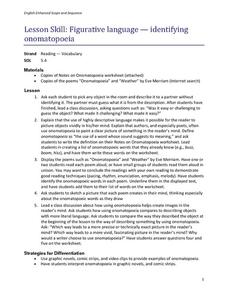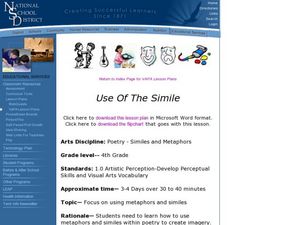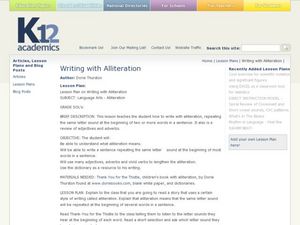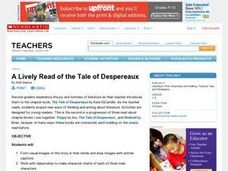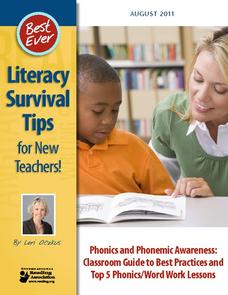Curated OER
Figurative Language- Identifying Onomatopoeia
A study of onomatopoeia for 5th graders is here for you. Pupils discover that the use of highly descriptive language makes it possible for readers to picture objects in their minds. After engaging in a class discussion and listening to...
Poetry4kids
Personification Poetry Lesson Plan
Scholars take part in two exercises to boost their knowledge of personification. After reading a detailed description and excerpts from famous poems, writers list action verbs and objects then combine words to create a humorous...
Curated OER
Writing with Vivid Verbs
Students find vivid verbs in literature and use them in their own writing. In this vivid verbs lesson, students use a 'Thinking Thesaurus' of major verbs to study common verbs. Students then practice rewriting sentences using vivid...
Curated OER
Conventions: Strong Verbs
Fifth graders practice using strong verbs. In this conventions lesson, 5th graders brainstorm words to complete sentences and list lively and exciting verbs. Students act out meanings of certain words. Students come up with new ways to...
Curated OER
Using Imagery
Show, don't tell! Pairs work together to change a list of telling sentences into showing sentences using picture words that create vivid pictures in the readers’ minds.
Prestwick House
Divergent
Veronica Roth's popular young adult novel shows a vivid dystopian system in an action-packed, thrilling storyline. Revisit Divergent with a crossword puzzle that features characters, plot, and important quotes from the book.
K12 Reader
Adjectives Describe
Vivid writers all start out the same way: learning in elementary school how to use a variety of adjectives! Young grammarians add adjectives to eight fill-in-the-blank sentences.
Curated OER
Vivid Adjectives
Students review adjectives and play a game where students compete to see who can write the most adjectives for a given noun. They write a story about one topic and try to use a variety of adjectives in sequence tto describe a noun.
Curated OER
Identifying and Using Parallelism and Balance in Literature
Students examine the story for use of balanced sentences and parallelism-two literary devices-and then practice using those devices in writing of their own. They combine the simple sentences grammatically into one correct sentence. A. I...
Curated OER
Vivid Verbs in Writing
Eighth graders explore how to incorporate vivid verbs in their writing. They review action verbs in sentences and view a Power Point presentation discussing possible verbs and their meanings. They view a website and retell a Greek myth...
Prestwick House
The Help
Kathryn Stockett's The Help opened up a rich, vivid world of strong female characters and stark societal injustices. As high schoolers read the novel, they complete a crossword puzzle that includes clues from all chapters of the book.
Great Books Foundation
Rattlesnakes
John Muir may be a friend to the natural world, but as a short reading passage confirms, he is no friend to rattlesnakes. As young readers learn about Muir's encounters with the dangerous creatures, they answer four comprehension...
Curated OER
Dialogue Tags
Use a presentation on dialogue tags in a narrative writing unit or a literature instructional activity. The first two pages of the resource detail the information and examples in the following slide show, making it a good reference page...
Curated OER
Vivid Verbs
Fifth graders review action verbs by brainstorming a list of them as a class. Using magazines, they pick one picture and use a dictionary or thesaurus to identify verbs that describe the action taking place. Using the new verbs, they...
Curated OER
Use of the Simile
Fourth graders identify and write their own similes. In this literary devices instructional activity, 4th graders define and identify similes. The teacher scaffolds the instructional activity so that all students can write their own...
Curated OER
Meaty Words
Headlines from newspapers launch a discussion of image-rich, meaty words. Just as headline writers choose vivid vocabulary to attract readers, young writers develop headlines that capture the essence of a passage from a book they are...
Curated OER
Use synonyms to make your writing vivid
Students examine synonyms and practice finding appropriate synonyms in a thesaurus. For this use synonyms to make your writing vivid lesson, students identify the correct usage of synonyms. Students replace incorrect synonyms in...
Curated OER
Animal Poems
Learners create their own acrostic poems. In this poetry lesson, students read poetry book to view examples of acrostic poems. Learners then write an acrostic poem using their name.
Curated OER
Imagine That! Analyzing Imagery
Poems by O. Henry, Marion Dane Bauer, Monty Roberts, and Langston Hughes provide the text for a study of symbolism, hyperbole, and imagery. Employing the “think-pair-share” strategy learners generate definitions of these terms and locate...
Curated OER
Writing with Alliteration
Students read Thank You for the Thistle and understand what alliteration is. In this alliteration lesson, students write sentences using alliteration. Students choose a letter of the alphabet and the class writes an alphabet book of...
Curated OER
Lively Read of the Tale of Despereaux
Students create a character map of the main characters in The Tale of Despereaux. After reading the text, students create a character chart based on information they gleaned from the story. They use this information to write a letter...
Curated OER
Pennies of My Life Part II
Youngsters write and construct their own autobiographies based on The Hundred Penny Box by Sharon Bell Mathis. They engage in pre-writing steps, narrative writing, and peer editing. This is the second part of a two-part project lesson.
International Reading Association
Literacy Survival Tips for New Teachers!
Whether new to teaching or a seasoned pro, this 12-page phonics and phonemic awareness guide is a must for your curriculum library. Everything from a summary of research on the topic to exercises and activities is included.
Curated OER
Writing Application: The Canterbury Tales
Students read stories from The Canterbury Tales by Geoffrey Chaucer and create their own tale. In this writing applications lesson, students read the tales and analyze the specific details that Chaucer use. Students work in groups to...


